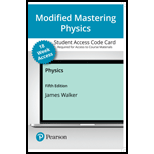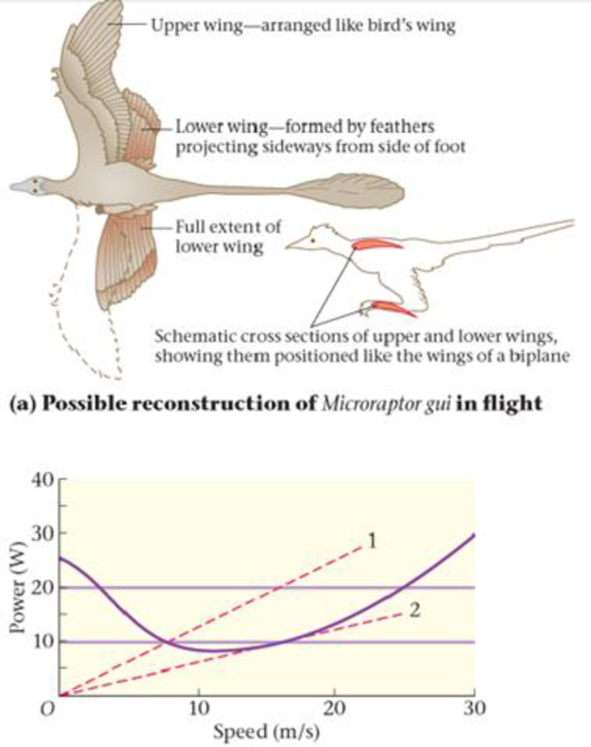
Concept explainers
BIO Microraptor gui: The Biplane Dinosaur
The evolution of flight is a subject of intense interest in paleontology. Some subscribe to the “cursorial” (or ground-up) hypothesis, in which flight began with ground-dwelling animals running and jumping after prey Others favor the “arboreal” (or trees-down) hypothesis, in which tree-dwelling animals, like modern-day flying squirrels, developed flight as an extension of gliding from tree to tree.
A recently discovered fossil from the Cretaceous period in China supports the arboreal hypothesis and adds a new element—it suggests that feathers on both the wings and the lower legs and feet allowed this dinosaur, Microraptor gui, to glide much like a biplane, as shown in Figure 7-31 (a). Researchers have produced a detailed computer simulation of Microraptor, and with its help have obtained the power-versus-speed plot presented in Figure 7-31 (b). This curve shows how much power is required for flight at speeds between 0 and 30 m/s. Notice that the power increases at high speeds, as expected, but it is also high for low speeds, where the dinosaur is almost hovering. A minimum of 8.1 W is needed for flight at 10 m/s. The lower horizontal line shows the estimated 9.8-W power output of Microraptor, indicating the small range of speeds for which flight would be possible. The upper horizontal line shows the wider range of flight speeds that would be available if Microraptor were able to produce 20 W of power.

Also of interest are the two dashed, straight lines labeled 1 and 2. These lines represent constant ratios of power to speed—that is, a constant value for P/U Referring to Equation 7-13, we see that
P/v = Fv/v = F
, so lines 1 and 2 correspond to lines of constant force. Line 2 is interesting in that it has the smallest slope that still touches the power-versus-speed curve.
85. What approximate range of flight speeds would be possible if Microraptor gui could produce 20 w of power?
- A. A. 0-25 m/s
- B. B. 25-30 m/s
- C. C. 2.5-25 m/s
- D. D. 0-2.5 m's
Want to see the full answer?
Check out a sample textbook solution
Chapter 7 Solutions
Modified Mastering Physics with Pearson eText -- Access Card -- for Physics (18-Weeks)
Additional Science Textbook Solutions
Campbell Biology in Focus (2nd Edition)
Anatomy & Physiology (6th Edition)
Concepts of Genetics (12th Edition)
Genetic Analysis: An Integrated Approach (3rd Edition)
Organic Chemistry (8th Edition)
Applications and Investigations in Earth Science (9th Edition)
- No chatgpt pls will upvotearrow_forwardBased on the two periods (from hand timed and ultrasonic sensor), find the value of 'k' they suggest from the physics and from the value of the hanging mass. hand time period is 1.472s and ultrasonic sensor time period is 1.44sarrow_forwardNo chatgpt pls will upvotearrow_forward
- Experimental Research Report Template Title: Paper Airplane Flight. Materials: Paper, ruler, tape Procedure: Fold paper into different airplane designs, such as dart, glider, or classic. Measure and record the distances each design flies when thrown with the same force. Discuss aerodynamics and the factors that affect flight distance. Introduction: (What do you expect to learn? What is the purpose of this lab? List any questions this experiment will answer.) Hypothesis: (Predict the outcome(s) of the experiment, must be in an “if…then format.) Materials: (What equipment and materials did you need for this experiment assignment? Describe how any equipment was connected. Also mention any special hardware or connections. List the name and amount of each item used.) Procedures: (What steps did you take to accomplish this lab assignment? Include Safety Precautions.) Data Collection: (Record the data that is required at each step of the…arrow_forwardTitle: Studying the Relationship Between Drop Height and Bouncing Height of a Ball: You can drop balls of different materials (e.g., rubber, plastic, ping pong) from various heights onto a flat surface and measure the height of their bounce using a ruler. Introduction: (What do you expect to learn? What is the purpose of this lab? List any questions this experiment will answer.) Hypothesis: (Predict the outcome(s) of the experiment, must be in an “if…then format.) Materials: (What equipment and materials did you need for this experiment assignment? Describe how any equipment was connected. Also mention any special hardware or connections. List the name and amount of each item used.) Procedures: (What steps did you take to accomplish this lab assignment? Include Safety Precautions.) Data Collection: (Record the data that is required at each step of the lab: tables, charts, graphs, sketches, etc.) Data Analysis: (Explain you…arrow_forwardA traveler at an airport takes an escalator up one floor as in the figure below. The moving staircase would itself carry him upward with vertical velocity component v between entry and exit points separated by height h. However, while the escalator is moving, the hurried traveler climbs the steps of the escalator at a rate of n steps/s. Assume that the height of each step is hs. (a) Determine the amount of chemical energy converted into mechanical energy by the traveler's leg muscles during his escalator ride given that his mass is m. (Use any variable or symbol stated above along with the following as necessary: g.) energy = (b) Determine the work the escalator motor does on this person. (Use any variable or symbol stated above along with the following as necessary: g.) work =arrow_forward
- Which of the following is part of the interior of the Sun? photosphere the corona sunspots radiation zonearrow_forwardMost craters on the surface of the Moon are believed to be caused by which of the following? faults asteroids volcanoes meteoroidsarrow_forwardAn object is subjected to a friction force with magnitude 5.49 N, which acts against the object's velocity. What is the work (in J) needed to move the object at constant speed for the following routes? y (m) C B (5.00, 5.00) A x (m) © (a) the purple path O to A followed by a return purple path to O ] (b) the purple path O to C followed by a return blue path to O ] (c) the blue path O to C followed by a return blue path to O ] (d) Each of your three answers should be nonzero. What is the significance of this observation? ○ The force of friction is a conservative force. ○ The force of friction is a nonconservative force.arrow_forward
- A block of mass m = 2.50 kg is pushed d = 2.30 m along a frictionless horizontal table by a constant applied force of magnitude F = 10.0 N directed at an angle 25.0° below the horizontal as shown in the figure below. m (a) Determine the work done by the applied force. ] (b) Determine the work done by the normal force exerted by the table. ] (c) Determine the work done by the force of gravity. ] (d) Determine the work done by the net force on the block. ]arrow_forwardA man pushing a crate of mass m = 92.0 kg at a speed of v = 0.845 m/s encounters a rough horizontal surface of length = 0.65 m as in the figure below. If the coefficient of kinetic friction between the crate and rough surface is 0.357 and he exerts a constant horizontal force of 294 N on the crate. e (a) Find the magnitude and direction of the net force on the crate while it is on the rough surface. magnitude direction ---Select--- N (b) Find the net work done on the crate while it is on the rough surface. ] (c) Find the speed of the crate when it reaches the end of the rough surface. m/sarrow_forwardTwo blocks, A and B (with mass 45 kg and 120 kg, respectively), are connected by a string, as shown in the figure below. The pulley is frictionless and of negligible mass. The coefficient of kinetic friction between block A and the incline is μk = 0.26. Determine the change in the kinetic energy of block A as it moves from to, a distance of 15 m up the incline (and block B drops downward a distance of 15 m) if the system starts from rest. × J 37° Barrow_forward

 Principles of Physics: A Calculus-Based TextPhysicsISBN:9781133104261Author:Raymond A. Serway, John W. JewettPublisher:Cengage Learning
Principles of Physics: A Calculus-Based TextPhysicsISBN:9781133104261Author:Raymond A. Serway, John W. JewettPublisher:Cengage Learning Physics for Scientists and Engineers: Foundations...PhysicsISBN:9781133939146Author:Katz, Debora M.Publisher:Cengage Learning
Physics for Scientists and Engineers: Foundations...PhysicsISBN:9781133939146Author:Katz, Debora M.Publisher:Cengage Learning Glencoe Physics: Principles and Problems, Student...PhysicsISBN:9780078807213Author:Paul W. ZitzewitzPublisher:Glencoe/McGraw-Hill
Glencoe Physics: Principles and Problems, Student...PhysicsISBN:9780078807213Author:Paul W. ZitzewitzPublisher:Glencoe/McGraw-Hill College PhysicsPhysicsISBN:9781285737027Author:Raymond A. Serway, Chris VuillePublisher:Cengage Learning
College PhysicsPhysicsISBN:9781285737027Author:Raymond A. Serway, Chris VuillePublisher:Cengage Learning University Physics Volume 1PhysicsISBN:9781938168277Author:William Moebs, Samuel J. Ling, Jeff SannyPublisher:OpenStax - Rice University
University Physics Volume 1PhysicsISBN:9781938168277Author:William Moebs, Samuel J. Ling, Jeff SannyPublisher:OpenStax - Rice University





